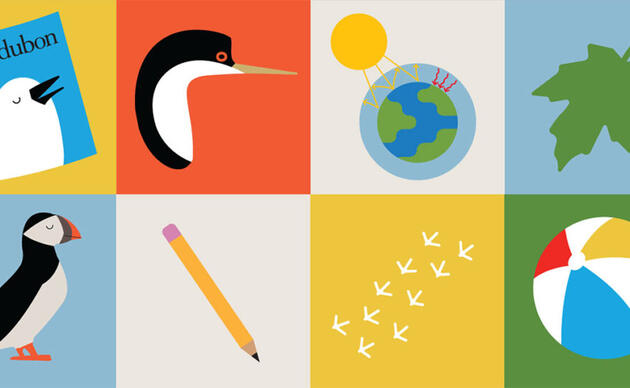Volunteer with us
Do you like to get out in the field for a good cause? Then sign up to receive updates about our ongoing citizen science efforts in California. We'll send you news about events and follow-up with reports about how your efforts have contributed to what we know about California's bird species.
OPPORTUNITIES IN CALIFORNIA
Bird Seasons CA
Ongoing (Pilot studies for Mount Diablo Audubon and Sea and Sage Audubon)
Phenology is the study of the timing of plant and animal life cycle stages (eg., leafing and flowering, emergence of insects and migration of birds). Local Audubon chapters are monitoring the timing of bird migration patterns, breeding, feeding, and other behaviors in IBAs to assess potential effects of climate change. Citizen scientist volunteers are conducting long term surveys and contributing to a national database, hosted by the National Phenology Network. Visit Sea and Sage Audubon's websiteto learn about their program.
Please contact Sandy DeSimone for more information regarding surveys. 949-858-0309
Black Oystercatchers
Weekly surveys are performed May through September at pre-selected sites of high species density
The central coast survey is part of a California coast-wide, multi-year effort to assess the Black Oystercatcher's reproductive success, as well as the habitat and threats to the habitat, in order to determine what actions need to be taken to assist with the long-term success of this charismatic bird. Learn more about Mendocino Coast Audubon's program...
Brown Pelican Count
Fall 2015
This will be Audubon California's first ever statewide Brown Pelican survey, in partnership with USFWS and eBird/Cornell Lab of Ornithology. More details will be posted this summer.
Christmas Bird Count
December 14, 2015 to January 5, 2016
From December 14 through January 5 each year tens of thousands of volunteers throughout the Americas brave snow, wind, or rain, and take part in the Christmas Bird Count. Audubon and other organizations use data collected in this long-running wildlife census to assess the health of bird populations - and to help guide conservation action. More, including how to find a circle near you...
eBird
Ongoing
Launched in 2002 by the Cornell Lab of Ornithology and National Audubon Society, eBird provides rich data sources for basic information on bird abundance and distribution at a variety of spatial and temporal scales. A birder simply enters when, where, and how they went birding, then fills out a checklist of all the birds seen and heard during the outing. eBird provides various options for data gathering including point counts, transects, and area searches. Add your checklist at the eBird website.
Great Backyard Bird Count
February 12-15, 2016
The Great Backyard Bird Count (GBBC) is a free, fun, and easy event that engages bird watchers of all ages in counting birds to create a real-time snapshot of bird populations. Participants are asked to count birds for as little as 15 minutes (or as long as they wish) on one or more days of the four-day event and report their sightings online at birdcount.org. Anyone can take part in the Great Backyard Bird Count, from beginning bird watchers to experts, and you can participate from your backyard, or anywhere in the world. More...
Hummingbirds at Home
Ongoing
Everybody loves hummingbirds, and now you can help scientists understand how climate change may be affecting their migration and breeding habits. People just like you all around the country will document which flowering plants hummingbirds are feeding on in their backyards as well as whether hummingbird feeders are supplied and used. Audubon researchers will use all the information they gather from citizen scientists to better understand how hummingbirds are impacted by feeders, non-native nectar sources in gardens, shifting flowering times, and climate change. Sign up at the Hummingbirds at Home website and learn about how Napa-Solano Audubon is using this program to educate the public about hummingbirds.
Least Terns
April – August 2015
Volunteers monitor Least Tern nesting colonies and record predator presence and behavior. They also note Least Tern behavior, such as courtship and reactions to disturbances. Volunteers can alert property managers to nuisance predators. Read more about San Diego Audubon and Sea and Sage Audubon's programs...
Richardson Bay Audubon Center and Sanctuary
Ongoing
Join us and help provide valuable conservation information on waterbirds and shorebirds in the Richardson Bay Audubon Sanctuary waters and in San Pablo Bay. We are looking for experienced birders to help with identification and counting, but non-experienced volunteers can assist with scribing.
• Richardson Bay waterbird surveys--we are looking for experienced birders to help with twice-monthly waterbird surveys between October and March.
• Shorebird surveys--we are looking for experienced birders to help with regular shorebird surveys for the Aramburu Island Enhancement Project.
• San Pablo Bay waterbird surveys--we are looking for experienced birders to help with waterbirds surveys for the Sonoma Creek Enhancement Project on the San Pablo Bay NWR.
Please contact Kerry Wilcox for more information regarding surveys. 415-388-2524 x101
Western Snowy Plover
Summer
There are many opportunities to help protect Western Snowy Plovers through Audubon chapters, State Parks, California Department of Fish and Wildlife, and other landowners. Help collect data during summer Snowy Plover surveys and fall shorebird surveys. More...
How you can help, right now
Get Audubon CA in Your Inbox
Our newsletter is fun way to get our latest stories and important conservation updates from across the state.
Donate to Audubon
Help secure the future for birds at risk from climate change, habitat loss and other threats. Your support will power our science, education, advocacy and on-the-ground conservation efforts.
HOTSPOT: Flyover of California's Birds and Biodiversity
California is a global biodiversity hotspots, with one of the greatest concentrations of living species on Earth.




